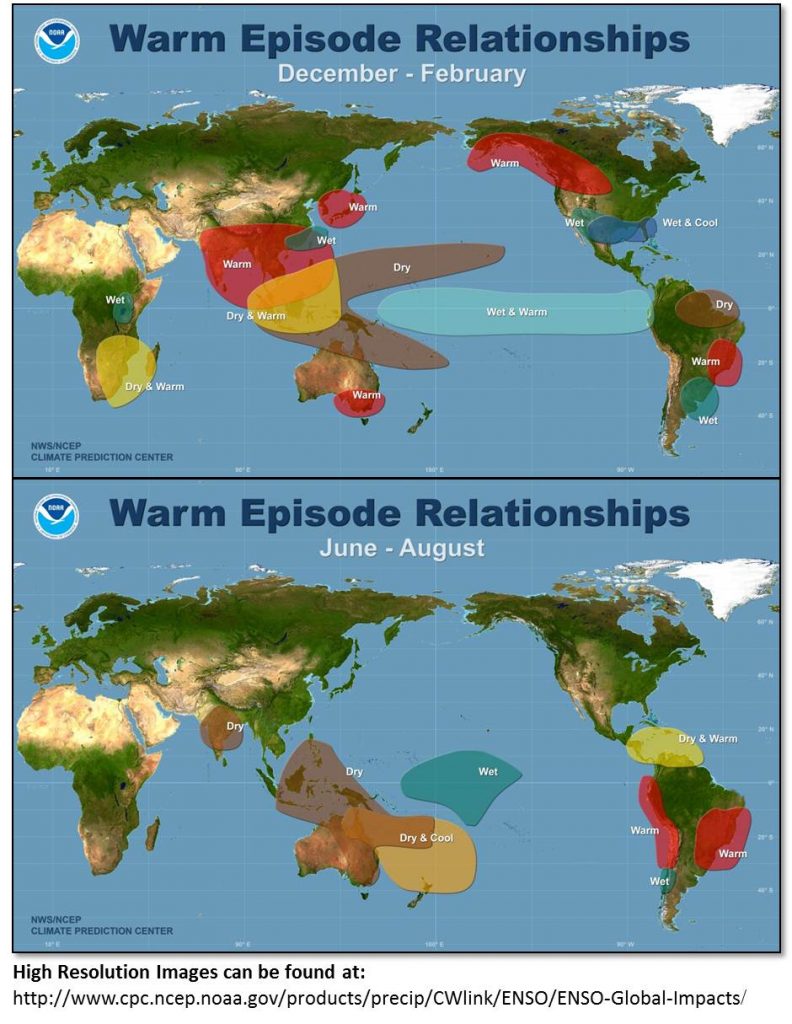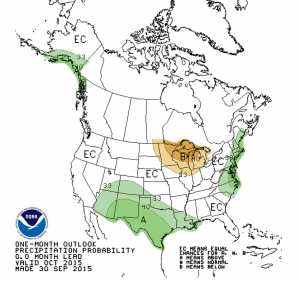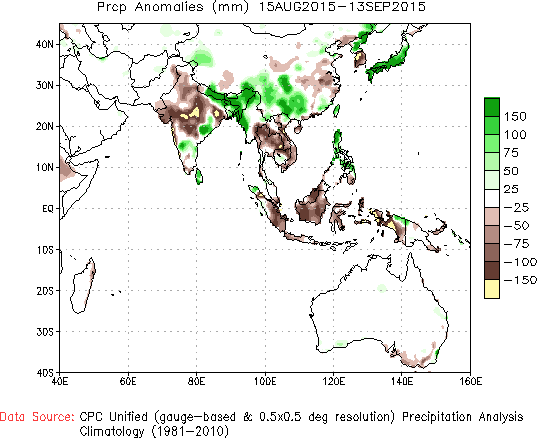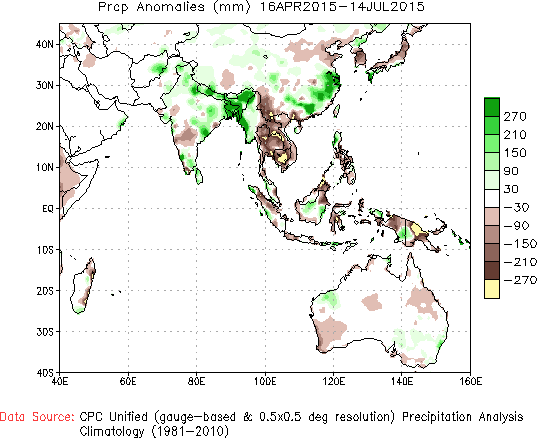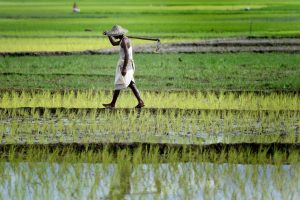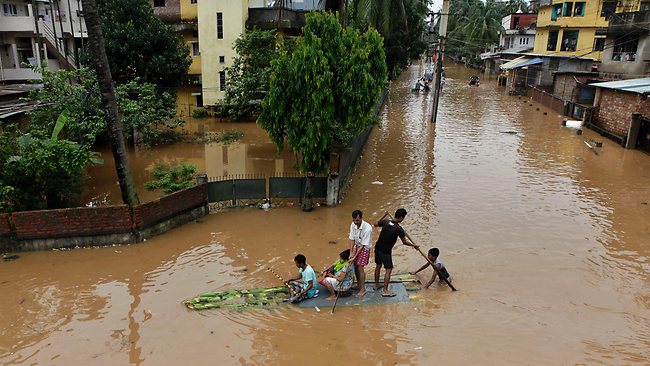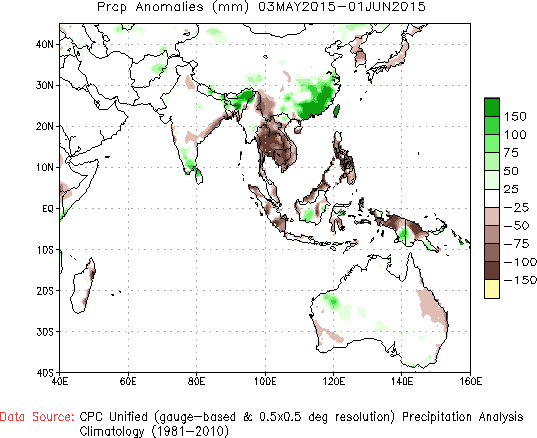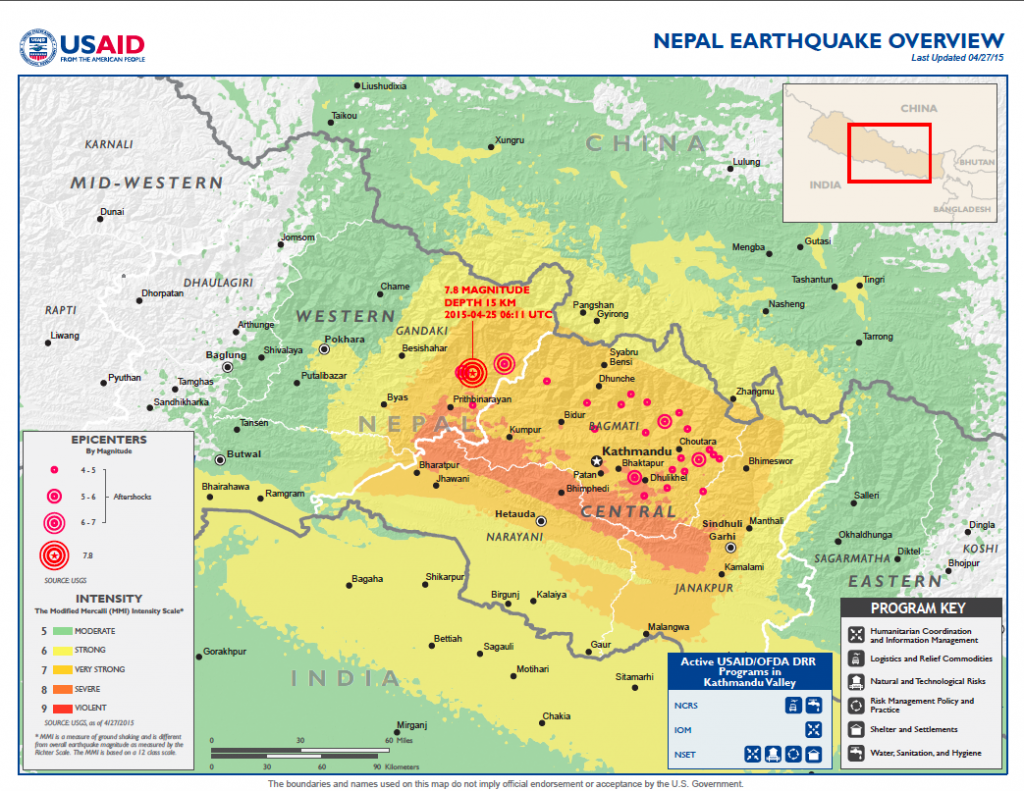Home » Blog (Page 2)
Category Archives: Blog
El Niño and climate change cause drought in southern Africa
By Harland Dahl
According to data collected from annual reports on rainfall in southeast Africa, mean summer rainfall has been steadily declining in the region over the past 200 years. It is suspected that this drying trend has been significantly influenced by climate change. Indeed, most climate models predict a reduction in rainfall over southern Africa in the next century, although there is less agreement amongst models for the northern parts of the continent. Today, we see strong year-to-year variability superimposed on these trends as African countries face both severe droughts and flooding.
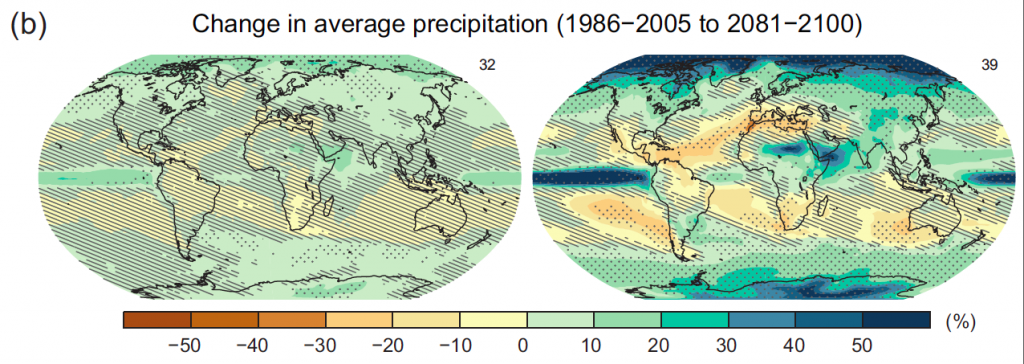
Many African nations faced severe droughts this past summer, including Tanzania, Kenya, Ethiopia, and Somalia. Strong El Niño conditions are expected to bring some relief to these countries over the next few months, as El Niño is typically associated with enhanced rain over east-central Africa. Although heavy rains are expected to be beneficial in these areas, storms also have the potential to cause dangerous flooding, particularly in the Horn of Africa.
South Africa, by contrast, is typically drier than usual during El Niño. If this region receives less rain than usual, this would compound existing dryness: the 2014/2015 season was the third-driest South Africa had seen in eighty years. In recent weeks, South Africa has faced several heat waves, some affecting the country’s maize belt. In response to water shortages, the South African government has imposed water restrictions in certain cities, and urged livestock farmers to limit their herd sizes to preserve water supplies.
According to David Nash, University of Brighton College of Life, Health and Physical Sciences professor, this year’s El Niño weather pattern could bring risks of serious droughts in southern Africa. In an interview with The Argus newspaper, Nash explained, “The timing of droughts shows a strong relationship with El Niño events, particularly during the latter half of the 19th century. Drought events were particularly severe during the rainy season immediately following an El Niño event.”

Droughts like these could be extremely threatening to food security in many areas of southern Africa, where 29 million people are food insecure and low levels of rainfall could lead to the death of livestock and reduced grain and cereal yields. In the past, weather crises like these have led to significant increases in staple food prices across African countries. In 2011, for example, staple prices were 68% higher than the region’s five-year average as a result of drought conditions. According to the United Nations, the countries most affected by staple price inflation often include Somalia, Ethiopia, and Kenya.
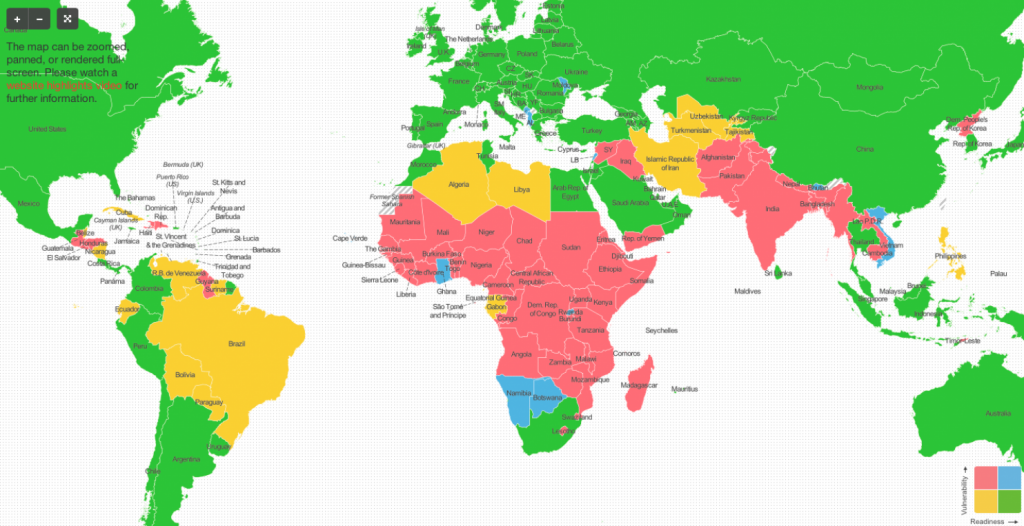
Southern Africa is particularly susceptible to the effects of climate change. According to recent climate models and research, it is possible that temperatures in southern Africa will increase one and a half times more quickly than the global average temperature increase in coming years.
In response to these threats, the World Bank has invested $US16 billion in a plan to help African countries prepare for and respond to climate change and its effects. This plan aims to help African countries “highly vulnerable to climate shocks” prepare for changes in weather patterns that could affect anything from health to infrastructure to crop production. It also includes efforts to boost clean energy production and increase access to electricity.
A summer of floods and hurricanes in Arizona ends with high temperatures
For the past three and a half months, Arizonans have faced substantial rains as a result of a heavy monsoon season. Arizona’s monsoon season usually lasts from June to September, bringing with it dust storms, thunderstorms, and hurricanes. The monsoon is influenced by winds originating in Mexico, pushing moisture Southwest though Arizona.
A strengthening El Niño in the Pacific Ocean may have contributed to the occurrence of tropical storms and hurricanes in this year’s monsoon. Some rains were particularly heavy, and the strong but sporadic monsoon was made up of both large rainstorms and smaller microbursts. While certain areas in northern Arizona remained dry, Phoenix and its surrounding areas received between 3.5 and 5.5 inches of rainfall.
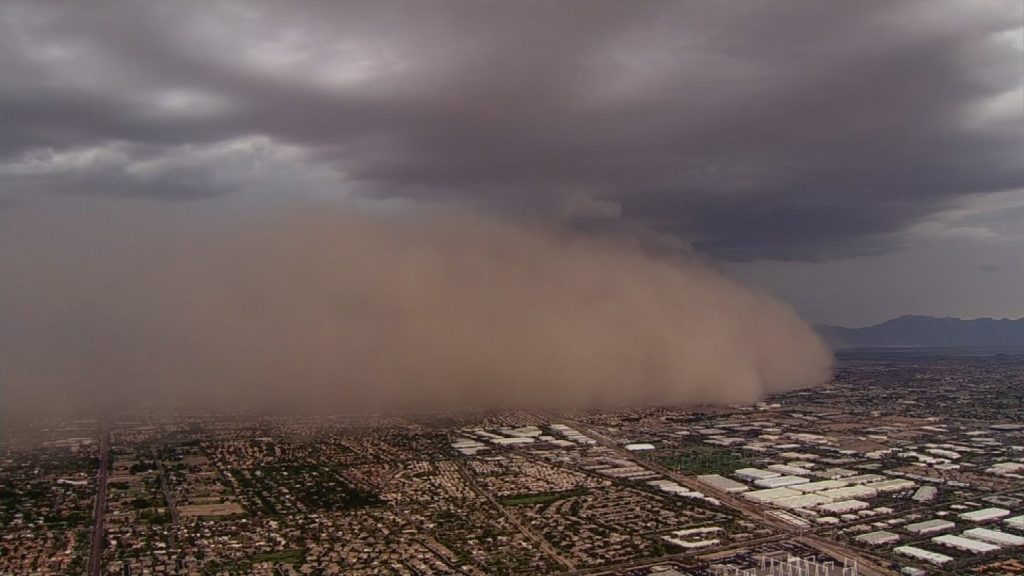
The rains began earlier than usual, with the emergence of Hurricane Blanca in June. By the end of June, rain levels were above average in much of Arizona. July saw a slight drop in precipitation, but the monsoon quickly recovered. Since then, several other storms have poured down on Arizona, including Hurricane Linda in September. The monsoon was the 35th wettest since 1896, and came to an end on Wednesday, September 30th.
According to the National Weather Service, some areas of Flagstaff, Phoenix, and Tucson received more than double the average monsoon season rainfall. These rains have helped to ease Arizona’s drought; today, nearly 57% of the state is no longer facing drought conditions. This is the highest percentage in five years.
Temperatures during this year’s monsoon were also warmer than usual. Throughout the monsoon season, Phoenix cooled to only 86 degrees. Temperatures in the southern parts of Arizona stayed high, as well. Daily lows in Yuma, for example, averaged the new high record of roughly 83 degrees. Last month was one of the warmest Septembers on record in Arizona.
Forceful monsoon storms threatened Arizonans and destroyed property throughout the state. Strong winds and hurricanes uprooted trees, blew off roofs, and tore down fences, forcing many families out of their homes. Weather conditions necessitated school and road closures in other parts of the state.
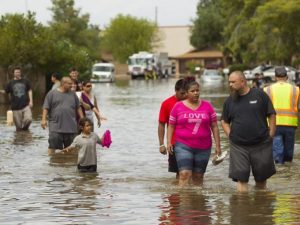
Monsoon rains have also caused dangerous and fatal flooding. A mid-September flash flood and resulting mudslide killed 16 people on the Utah-Arizona border. In Mesa, Arizona 200 homes were flooded by monsoon rains before responders were able to open a floodgate. Dozens of cars across Arizona have been trapped in flash flooding, as well.
Many of Arizona’s cities lack the necessary infrastructure to protect citizens from monsoon rains. In response to this problem, the state government has implemented several programs to strengthen recovery efforts and fortify infrastructure. In Phoenix, for example, $7.5 million has been allocated towards emergency response programs and the building of a 36-acre storm water retention basin to contain rainfall.
According to a representative from the Phoenix office of the National Weather Service, there is a sixty to seventy percent possibility of Arizona’s winter having an above average rainfall. As warm-weather conditions caused by El Niño migrate through Arizona, snowfall may be delayed until later in the year. The National Weather Service predicts that snow many not begin until late December.
Weak southwest monsoon leads to water, electricity shortages in India
By Harland Dahl
In June, the India Meteorological Department published a seasonal forecast predicting that the southwest monsoon would bring “below normal” levels of rain to India at 90% of average rainfall. As of August 10th, monsoon rainfall was below this prediction by 6%, at 84% of average rainfall.
Today, India faces a 16% rainfall deficit. As a result, Indian communities are feeling the strains of water shortages as they enter into a second year of drought. According to recent meteorological data, the southwest monsoon could begin to withdraw from northwest India in the next three or four days. The monsoon has already withdrawn from parts of Rajasthan, Punjab and Haryana, and now appears to be passing through Amritsar, Hisar, Ajmer, and Barmer.
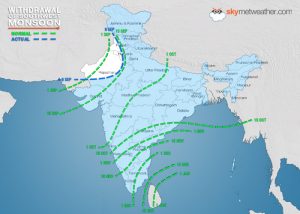
This would leave one quarter of the country in a rain deficit. In fact, 91 key reservoirs across India have recorded less water reserves as compared to this period last year. Reservoirs in the South face the most serious deficiencies, with reservoirs in East and West India facing less severe deficits.
On September 10th, the 91 key reservoirs were recorded as filling only 59% of their storage capacity. An official statement released Friday by the Ministry of Water Resources explained that, “This storage is 77% of the storage of corresponding period of last year and 81% of storage of average of last 10 years.”
Indian citizens are already experiencing the impact of these rainfall deficits. In response to low reservoir water levels, the Water Resources Department has restricted the amount of water used for purposes of power generation.
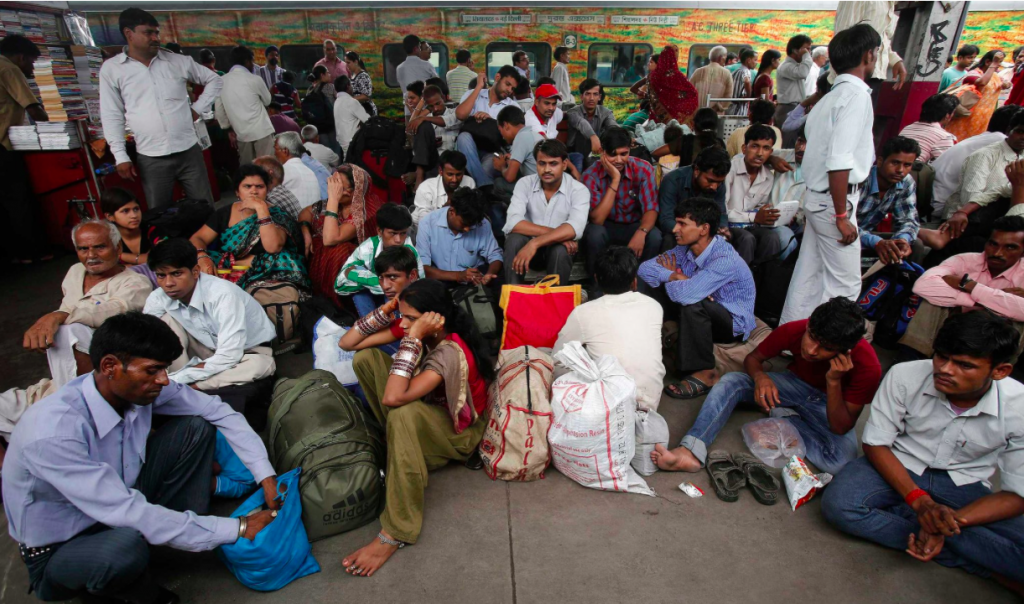
Resulting power shortages have led to multiple unscheduled power cuts over the last week in the Indian state of Odisha. Power suppliers are now in the process of implementing statewide scheduled power usage regulations to conserve energy until the situation improves. Power shutoffs in urban areas are expected to be from one to two hours long, while rural areas will face more severe restrictions.
Deficient monsoon rains may also lead to low agricultural yields. The southwest monsoon’s rains irrigate almost half of India’s agricultural land, including many small family farms. Forecasts predict that this year will be the driest since 2009, leaving soil too dry to sustain winter crops.
Earlier this week, RPG Foundation President D. H. Pai Panandiker explained that the weak monsoon could cause agricultural production to fall by nearly 3% this year. Poor families living in rural areas could bear the brunt of this decrease, as many poor Indian families rely on crops from small family farms for sustenance and economic stability.
Although shortages as a whole have increased, some states have collected more water this year than the last. These include Himachal Pradesh, Punjab, Rajasthan, West Bengal, Tripura, Gujarat, Uttarakhand and Madhya Pradesh. While rains from these areas have not been sufficient to make up for the water deficit, they have caused dangerous flooding in hundreds of Indian villages.
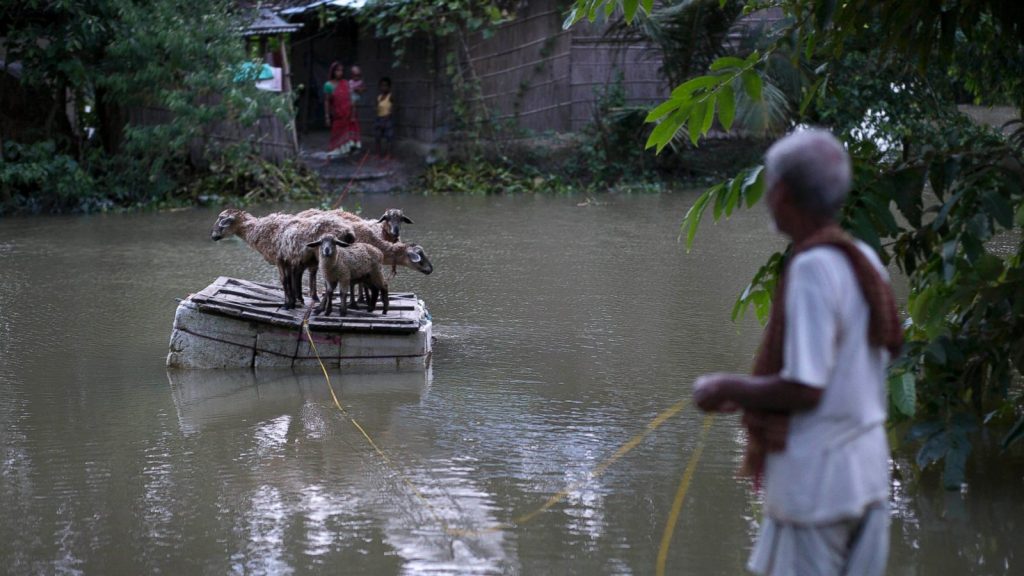
As of September 1st, nearly 800,000 Indian citizens had been forced to leave their homes, and 21 others were killed as a result of the floods. India’s disaster management authority announced that 168 relief camps were sheltering nearly 50,000 of those displaced by the flooding.
Heavy rains, flooding prove deadly in Myanmar
By Harland Dahl
Twelve of Myanmar’s fourteen regions are facing severe flooding, a result of abnormally heavy monsoon rains. Flash flooding and landslides have affected more than 330,000 of Myanmar’s people and killed 88 others, according to the country’s Ministry of Social Welfare, Relief, and Resettlement.
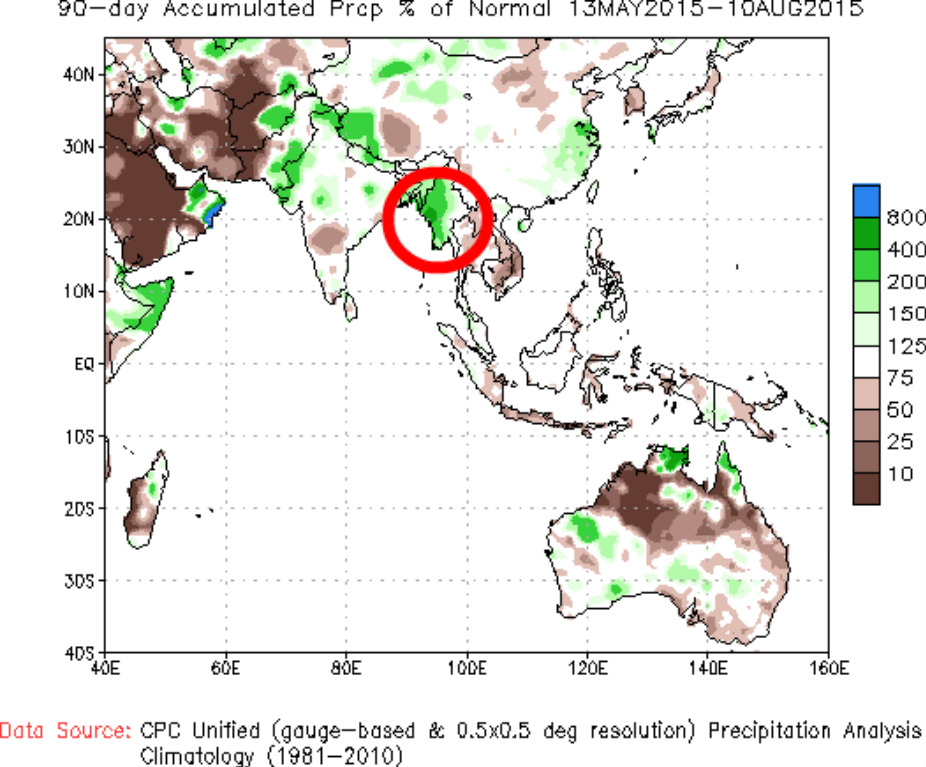
In the last few weeks, monsoon rains have swept through much of South and Southeast Asia, killing hundreds and displacing millions. In Myanmar, this monsoon has affected many of the country’s poorest who often live in low-lying regions most vulnerable to flooding.
The states hit hardest by heavy rains and flooding include Rakhine and Chin. The state of Rakhine has suffered the most casualties; Cyclone Komen killed 57 people in Rakhine last week.
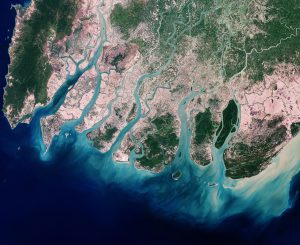
Other people of Myanmar most at risk include those living in the southwest Ayeyarwady delta region, home to 12 percent of Myanmar’s population. Myanmar President Thein Sein has instructed inhabitants to seek shelter on higher land as the region’s rivers start to rise. In response to this and other warnings, many people of Myanmar have taken refuge in monasteries and makeshift shelters to protect themselves from the monsoon and the dangers it brings.
Myanmar’s flooding threatens not only homes and infrastructure, but has also destroyed crucial agricultural land and resources. This loss of resources, including 200,000 acres of destroyed farmland, could mean heightened levels of malnutrition for Myanmar’s poorest. Dom Scalpelli, director of the United Nation’s World Food Programme, explained, “Thousands of people have lost their homes, livelihoods, crops, and existing food and seed stocks. Food security will be seriously affected [by the monsoon].”
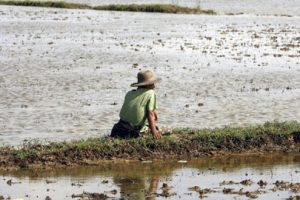
The government of Myanmar, which took power in 2011 and will face elections this November, is facing criticism from citizens for its response to the monsoon. Although the government has attempted to relocate at-risk people and rebuild communities, it has been accused of understating the magnitude of the crisis and being slow to warn citizens of impending dangers. Last week, the New Light of Myanmar, a government-owned newspaper, conceded that, “the government’s weak response to the disaster led to misunderstandings about evacuation efforts.”
On August 4th, the government of Myanmar announced that it had appealed for international assistance to provide relief for its people in the forms of temporary shelter, food, and clothing. A spokesman for the president’s office explained, “We are cooperating and inviting international assistance. We have started contacting possible donor organizations and countries. “
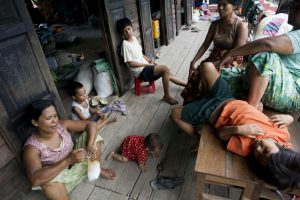
Myanmar is now receiving aid from various organizations and countries, including the United Nations, Save the Children, and the government of Australia. On August 7th, the United Nations authorized $9 million in aid from the UN Central Emergency Response Fund to be allocated to aid organizations working in Myanmar.
These funds are intended to speed up relief efforts by helping to provide emergency shelters, safe food and water supplies, improved sanitation services, and emergency health care. As of this week, over 387 metric tons of food and 620,000 water treatment tablets have been distributed to the people of Myanmar.
Thailand drought leaves lasting effects, even as rainy season begins
By Harland Dahl
While some areas of Thailand currently face heavy monsoon rains, others suffer from the effects of a drought that began in November of 2014. This was the worst drought experienced by Thailand in over a decade.
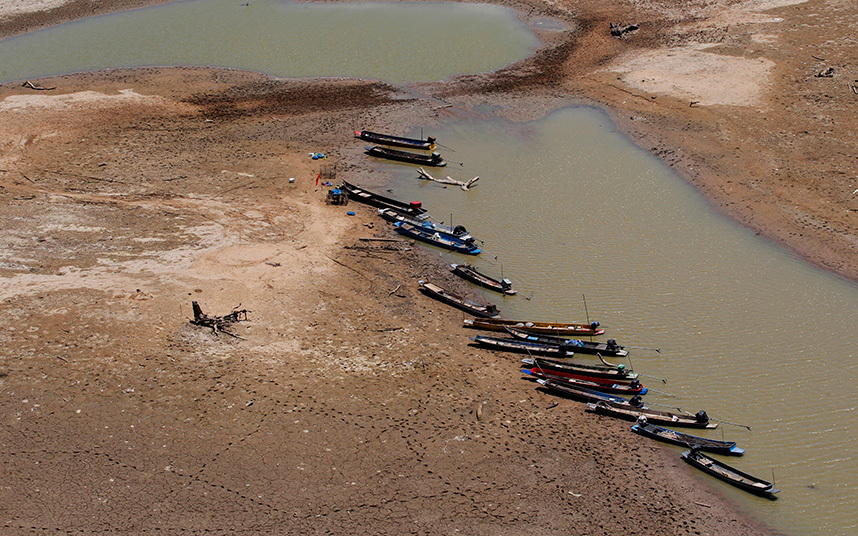
The drought has had lasting negative effects on Thailand’s agricultural sector and has led to difficulties in rice farming, a crucial crop for Thai farmers and families. Thailand is the world’s largest rice exporter, with rice farming taking up 40% of Thai agricultural land and representing a significant portion of Thailand’s labor force and economy.
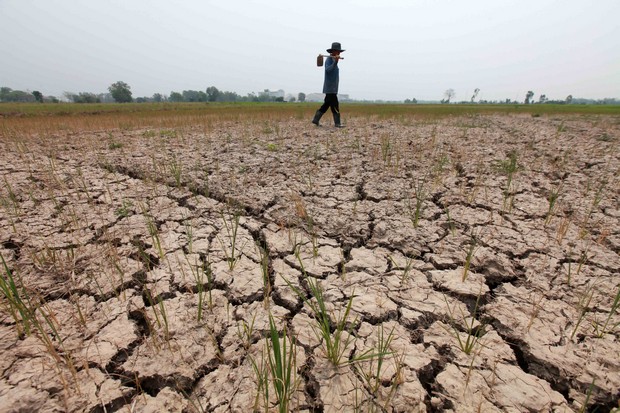
Other crops have been affected, as well, threatening the livelihood of many Thai citizens. Over half of Thailand’s working age population is supported by the agricultural sector.
In response to water shortages caused by the drought, the Thai government has asked farmers to delay rice production. Thai Minister of Agriculture and Cooperatives Petipong Pungbun Na Ayudhya explained, “The agriculture ministry and irrigation department have requested that farmers delay rice planting in the Chao Phraya area because the Chao Phraya area is a large rice growing area… and we need to organize the water that is being used.”
By delaying rice production, the government hopes to reduce nonessential water usage until monsoon rains bring relief from the drought. Thailand’s rainy season usually lasts from May to October, bringing an average of 2.4 meters of rain to Thailand’s southern regions, and 1.4 meters to the northern and central parts of the country.
Although Thailand’s rainy season had already begun, as of July 6th, 22 of the country’s 76 provinces were still facing drought conditions. The Thai Meteorological Department anticipates that this year’s rainy season will deliver mostly “near normal” rains. A report published by the department on June 26th predicts that the southwest monsoon will begin to travel north in July, bringing heavy to very heavy rains to Upper Thailand. Then, as is typical in the seasonal cycle, the rainfall maximum of the South Asian monsoon will shift southward in October towards Southern Thailand.
The Thai government is struggling to simultaneously provide relief from the drought, implement a water management plan to safeguard against future droughts, and prepare for threats presented by monsoon rains.
In response to the drought, the Thai government has implemented a system of daily water delivery to the most drought-affected areas using water trucks. Unfortunately, these efforts have often been insufficient to fulfill many communities’ water needs. The government has also used cloud seeding technology to create artificial rain to aid Thai farmers who depend on rice farming for their livelihood and keep rice production levels up.
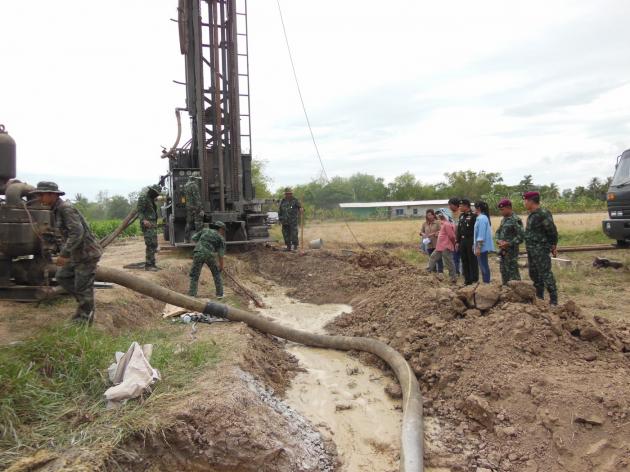
Thailand has also announced a plan to invest $7.5 billion in water management projects in the coming years. These include a 10-year water management plan, a replacement for the less successful management plan of a previous regime.
The start of the rainy season has already led to flooding and mudslides in Bangkok, as well as in Thailand’s Central Plans. To prepare for future rains, the government has begun to dig waterways to contain rainwater and use social media to warn citizens of flooding risks.
Scientists Predict Strong El Nino for 2015
Government research centers and universities around the world are predicting that 2015 will bring a strong El Nino event. On NOAA’s ENSO blog, Emily Becker from the National Weather Service Climate Prediction Center, writes, “forecasters currently favor a ‘strong’ event for the fall/early winter”. The UK Met Office has also indicated that their models “suggest that this El Nino could strengthen from September onwards”. Some scientists are even warning that current conditions are reminiscent of the 1997 El Nino – the most severe on record. A report released by the Australian Bureau of Meteorology notes the abnormally warm sea-surface temperature observed in the Pacific Ocean over the last 2 weeks: “It is unusual to have such a broad extent of warmth across the tropical Pacific; this has not been seen since the El Niño event of 1997-98.”
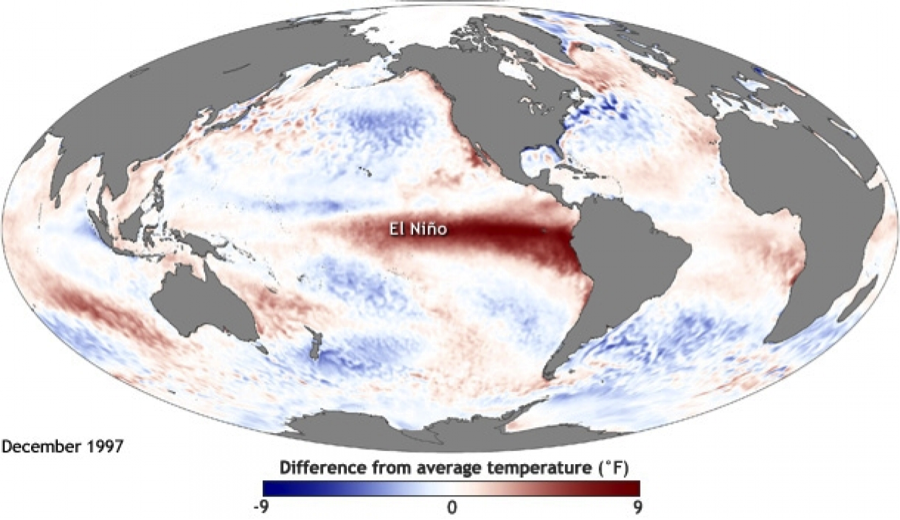
An El Nino event entails warmer than usual sea-surface temperatures in the Pacific Ocean, which in turn impact weather systems around the world — triggering high temperatures, poor monsoons, and drought in Asia and east Africa, while causing heavy rains and floods in South America. Prof. Adam Scaife, of the UK Met Office’s Hadley Centre, said “With the current event, things like the Indian monsoon, tropical West Africa, the maritime continent [Indonesia], and Australian impacts are all appearing in current forecasts – all of those regions are at increased risk of drought.”
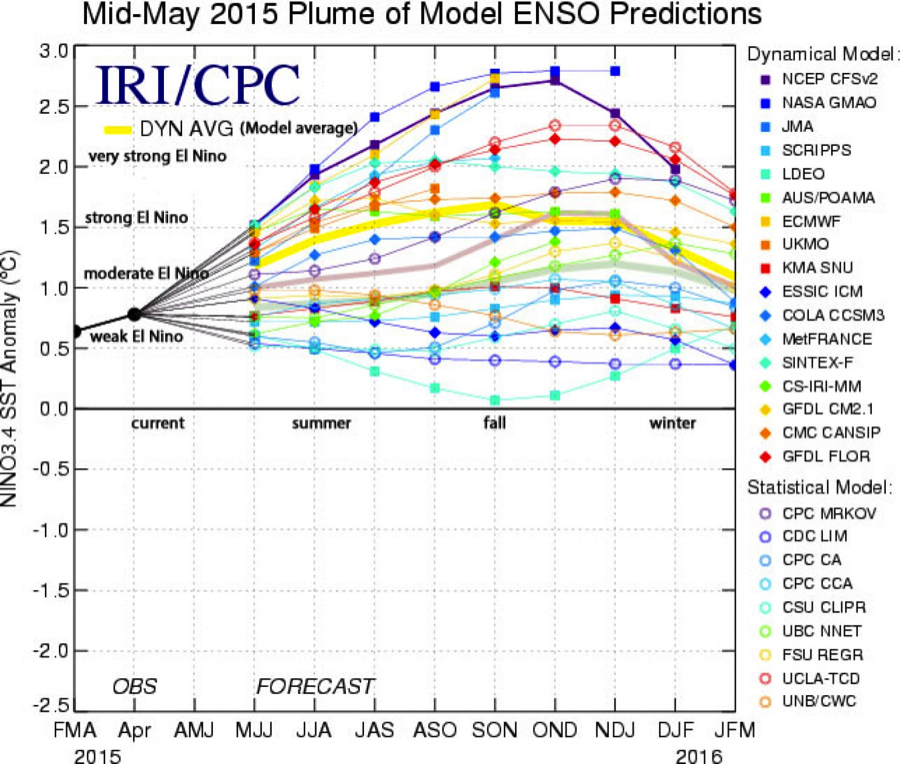
El Nino events occur approximately every 2 to 7 years as part of a natural ocean-atmospheric cycle, though some research suggests that extreme El Nino events will become more frequent under climate change. Additionally, this year’s El Nino event could prompt record-breaking global temperatures, as the first four months of 2015 have already been the warmest on record according to the NOAA and NASA.
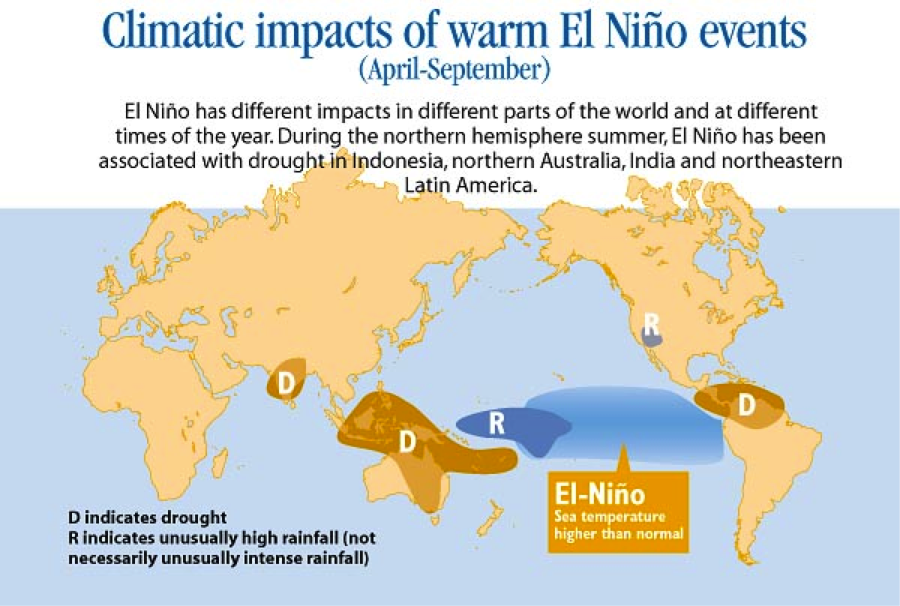
A strong El Nino will be extremely hazardous for countries whose economies are highly dependent on agriculture, with crop failure and rising food prices creating food insecurity. The arrival of El Nino is most significant in regions where the main cropping season has just begun, such as in South Asia and West Africa; rain-fed rice production in South and Southeast Asia will be affected by the suppressed monsoon rains. In 2009, El Nino caused the worst drought in 40 years in India. In an interview with Reuters, K.K. Singh, the Head of the Agricultural Meteorology Division of the Indian Weather Office noted, “Crops like soybean and cotton are under El Nino watch for being sown mainly in rainfed conditions. El Nino looms large over soybean areas of the central parts and cotton belts of the western and the northern regions.”

A strong El Nino year is likely to disrupt food markets and elevate prices of staple food crops such as rice, coffee, sugar and cocoa. Some reports estimate that an El Nino event can cause tens of billions of dollars of economic damage to the Asia-Pacific region. In a country like Indonesia, where the agriculture, forestry, and fisheries sectors account for 18% of the GDP, historically, El Nino events have caused a percentage drop in the GDP and spiked inflation.
Monsoon affects economy, health in India
By Harland Dahl
India’s monsoon hit the Southern Indian state of Kerala on Friday, June 5th, four days later than expected. With monsoon rains comes relief from India’s stifling heat wave, which began in May.
The Indian Institute of Tropical Meteorology predicts that the monsoon will spread across most of India by the end of June. Rains are expected to reach the country’s West coast by June 17th and central India by June 25th. The India Meteorological Department predicts that the monsoon will be weaker than usual, bringing less than 90% of typical monsoon rainfall.
It is estimated that crop planting in India has gone down by 9% since last year. This is due to weak monsoon rains, which not only lead to low crop production, but to high food prices. The crops most affected are grains and cotton.
In response, the Indian government has taken several steps to boost agricultural production. The India Meteorological Department has begun to send mobile weather alerts to farmers, and public officials have been promoting the cultivation of more drought-resistant crops.
Minister of Agriculture Eknath Khadse explained, “Growing vegetables and fruits would be our priority. This will give farmers something for daily survival, without too much investment, along with the main crops ahead of the kharif season.”
The agricultural sector employs more Indian citizens than any other sector of the economy. This means that a below-average monsoon could have a significant effect on the Indian economy, as a whole. The ICICI Bank of India estimates that weak rains will cause a drop in India’s GDP growth for this fiscal year, from the originally estimated growth rate of 7.8% to 7.3%.
But even during a relatively dry year, monsoon rains have the potential to negatively impact other sectors of the Indian economy, as well. Heavy rains put crucial infrastructure at risk throughout India, and are particularly threatening to burgeoning industrial cities such as Bangalore, home to 30% of India’s startup companies.
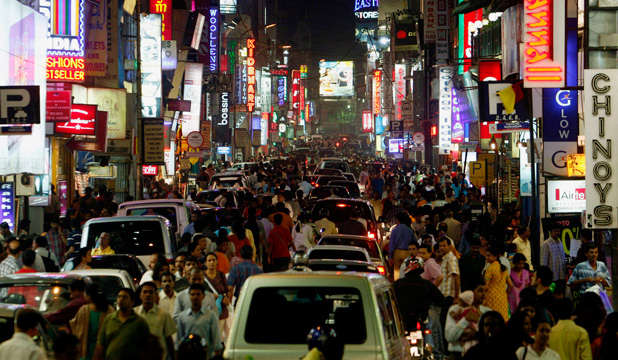
With heavy rains come blackouts and losses in internet connectivity. While larger corporations can afford more reliable internet connections, smaller companies often depend on unreliable nationwide internet service providers or local cable networks.
Weakened infrastructure has also lead to sanitation problems in many parts of India, particularly in poorer parts of the country’s largest cities. Although overall water contamination levels have gone down in the past decade, contamination usually rises significantly during monsoon season.
Rising underground water levels during the monsoon season affect outdated underground sewages systems and leaking pipes, leading to abnormally high levels of E Coli and other bacteria. These bacteria cause diarrheal disease and various water-borne illnesses.
Vector-borne diseases such as malaria and dengue are also particularly prominent during monsoon season. To avoid exposure to contaminants, Indians are encouraged by health officials to take precautionary measures such as boiling all drinking water and only eating foods stored inside.
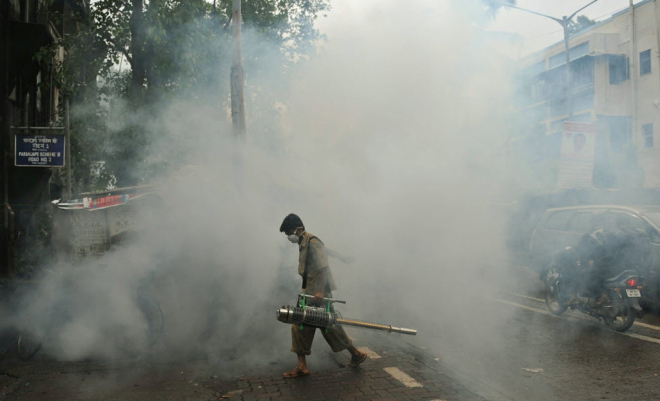
Fumigation efforts are also ramped up during monsoon season, which is also breeding season for mosquitos. Those most affected by both vector and water-borne diseases include children and the elderly, often due to time spent outside or an inability to fend off infection.
India awaits monsoon after deadly heat wave
By Harland Dahl
India faces a heat wave annually, but this year temperatures have been higher than normal. As of June 2, the heat wave’s death toll reached over 2,300. This makes the 2015 Indian heat wave the fifth deadliest heat wave in world history, and the second deadliest heat wave in Indian history.
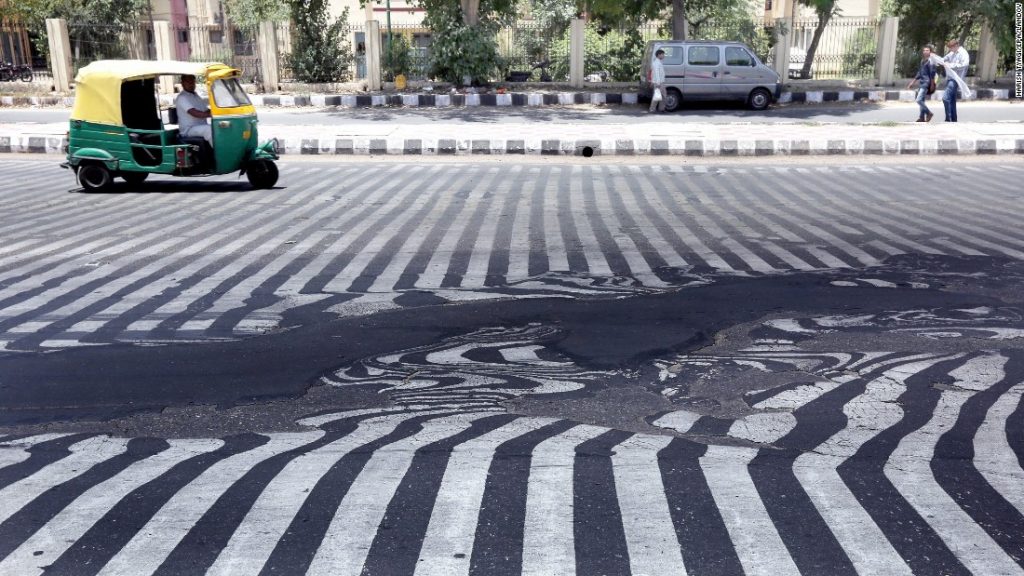
The states most affected by the heat wave were Andhra Pradesh and Telangana in southeast India, with 1,490 and 489 deaths, respectively. Other deaths occurred in the states of Uttar Pradesh, Punjab, Odisha, and Bihar.
The poor, who must continue to work to support themselves despite soaring temperatures, have suffered the most casualties. These include construction workers, many working as day laborers in the nation’s capital. Elderly Indians have also been disproportionately affected by the heat wave. These casualties are often the result of heat stroke or dehydration.
The heat wave lasted for weeks, bringing temperatures up to about 120 degrees Fahrenheit. The abnormally high temperatures are likely related to the infrequent pre-monsoon season rains. These rains brought less water to India than they have in the past, leaving Indian cities hot and dry.
The approaching monsoon season has already begun to bring relief for Indian citizens suffering from these high temperatures. Unfortunately, the monsoon, which was expected to arrive between May 29th and 31st, has been delayed. Light to moderate rainfall occurring before the onset of the continental-scale monsoon has cooled some regions, and most regions have cooled somewhat in the past few days.
Meteorologists have delivered conflicting predictions as to when the monsoon will arrive, but many agree that it will be around June 4th or 5th. When the monsoon arrives, its rainfall generally expands northward across India.
This means continued danger for already at-risk Indian citizens. In order to combat this threat, the Indian government has taken several precautionary measures. These include the distribution of oral rehydration kits and administration of intravenous fluids in public places such as bus stops and train stations.
Indians, many of whom have been suffering from headache and dizziness, have tried various methods to stay cool. In some cities, the demand for air conditioning in response to the heat wave has led to power outages. In other areas, Indians have been spending the warmest part of the day in rivers or streams to cool off. The government has also advised citizens to remain indoors or in the shade as much as possible.
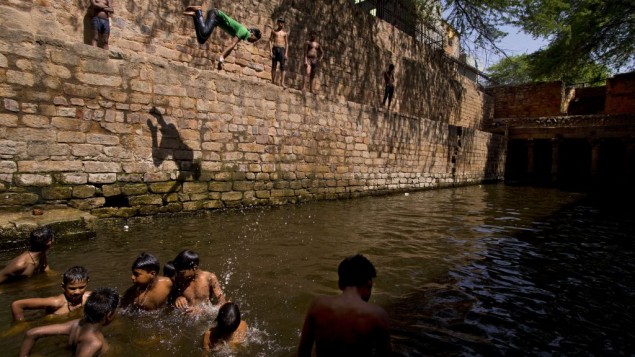
When the monsoon does arrive, it is possible that it will bring less rainfall than usual. The summer monsoon, which typically lasts from June to September, is predicted by the India Meteorological Department to bring levels of rain that are “below normal” — only 90% of normal according to their just-issued seasonal forecast. Last year this was also true, with the 2014 monsoon resulting in a 12% rainfall deficit. This year the monsoon could be inhibited by the current El Niño event that is predicted to strengthen during summer.
Hotter temperatures are generally expected to result from climate change. India’s National Disaster Management Authority states that climate change has caused more frequent and severe Indian heat waves in recent years.
The Intergovernmental Panel on Climate Change agrees, reporting that “higher daily peak temperatures and longer, more intense heat waves are becoming increasingly frequent in South Asia as a result of climate change.”
Limited rains like these could mean a lasting drought and limited agricultural production for India. As the monsoon brings four-fifths of India’s annual rainfall, it is crucial for millions of Indian farmers.
Two earthquakes bring health risks to Nepal
By Harland Dahl
A 7.3 magnitude earthquake hit Nepal last Tuesday, only two weeks after a devastating 7.8 earthquake shook the country on April 25th. These earthquakes killed over 8,000 people and displaced close to 3 million others.
Today, Nepal’s government and organizations are struggling to rebuild critical infrastructure and provide those affected with food and shelter.
Many factors have made relief efforts challenging, including Nepal’s mountainous terrain, the high proportion of Nepalese people living in rural areas, and limited funding. These efforts are further complicated by the impending monsoon season.
Nepal’s monsoon season is expected to begin in June, giving aid workers between three and five weeks to prepare for heavy rains. The monsoon season usually lasts from June to September, bringing Nepal 80 percent of its precipitation for the year. Nepal’s average annual rainfall is 1.6 meters (about 5 feet), with some regional variation across Nepal.
With monsoon season comes many risks for Nepalese people. Heavy rains lead to water-borne diseases, sanitation problems, the contamination of drinking sources, and worsened living conditions. The impending monsoon will also present challenges for the Nepalese government and international organizations attempting to deliver aid. To combat these threats, the government and aid organizations are focused on improving infrastructure and sanitation before the monsoon hits.
The earthquakes destroyed or damaged much of Nepal’s sanitation and water infrastructure, including water pipes and latrines. In response, the Nepalese government has announced a plan to construct temporary pit latrines in the weeks before the monsoon hits. They hope to build one latrine for every 50 Nepalese males and every 30 Nepalese females.
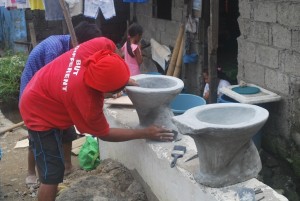
Aid organizations such as the UN and OCHA have focused on providing temporary shelter for families whose homes were rendered uninhabitable by the two earthquakes. It is imperative that these temporary shelters be provided prior to the start of the monsoon season in order to give earthquake victims protection from health risks brought by heavy rains.
While some displaced people use “Shelter Kits” provided by agencies such as the UK’s Department for International Development, others use vegetation and materials found in rubble to build shelter for their families. Buildings that survived the earthquakes are also being used as emergency shelters, including schools and some governmental buildings.
The monsoon will also cause logistical problems for the Nepalese government and aid organizations. Rainstorms will make travel and the transport of food and supplies to remote communities especially difficult. Relief operations will not only encounter flooding and mountainous terrain when attempting to deliver aid, but an increased risk of landslides, a result of earthquakes worsened by the start of monsoon season. Helicopters, which are often used to deliver aid to hard-to-reach regions, will be grounded by the heavy rains, as well.
Relief workers are attempting to combat these logistical barriers by changing the methods they use to reach affected populations. In lieu of vehicles, some aid workers have begun to carry supplies to rural communities by foot. Other workers have been using mules, donkeys, and paid porters to deliver supplies to remote locations. The Nepalese government has also taken advantage of social media as a way of warning citizens of impending rainstorms and informing citizens of where and how to acquire supplies and relief.
With funding low, many relief organizations are having difficulties implementing relief operations before the start of the monsoon season. The United Nations, for example, has announced that it has only raised 20 percent of the estimated $432 million necessary to carry out its planned relief operations.
Forthcoming Monsoon Rains May Complicate Disaster Relief Efforts in Nepal
by Nina Horstmann
On April 25, a 7.9 magnitude earthquake struck Nepal. While reports about the extent of damage in rural areas are still trickling in, the UN currently estimates that over 8 million people have been affected by the quake and the Nepali government has accounted for over 7,000 fatalities. Since the quake, persistent aftershocks have triggered further avalanches and landslides, compounding the destruction. In addition to the capital city of Kathmandu, remote mountainous areas of Nepal have been particularly impacted, yet the ability of relief efforts to reach these areas has been impeded by the devastation.
The South Asian monsoon circulation brings rainfall to Nepal from June to September; during these 3 months the southwest monsoon brings more than 75% of the annual rainfall. The monsoon is critical for agricultural production in Nepal, which relies on monsoon rains for irrigation. According to the Nepali Department of Agriculture, the agriculture sector employs 2/3 of the population and makes up nearly 35% of the GDP.
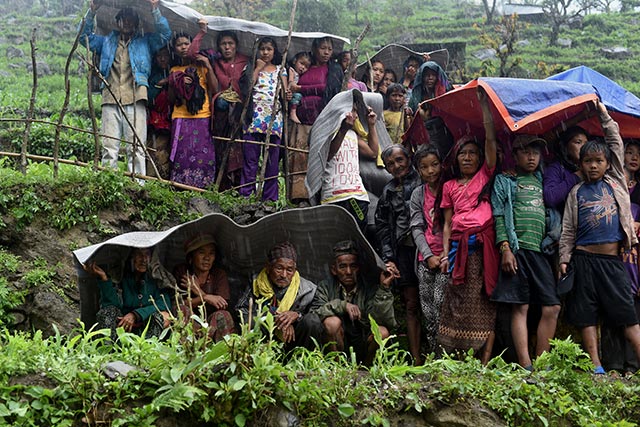
Impending monsoon rains may frustrate relief efforts. Sienna Craig, a professor of Anthropology at Dartmouth University who has worked in Nepal for over 20 years, notes that monsoon rains will bring further challenges to the region, complicating access to clean water and triggering landslides that may frustrate reconstruction efforts. Pre-monsoon rains have already curtailed humanitarian aid in the region.
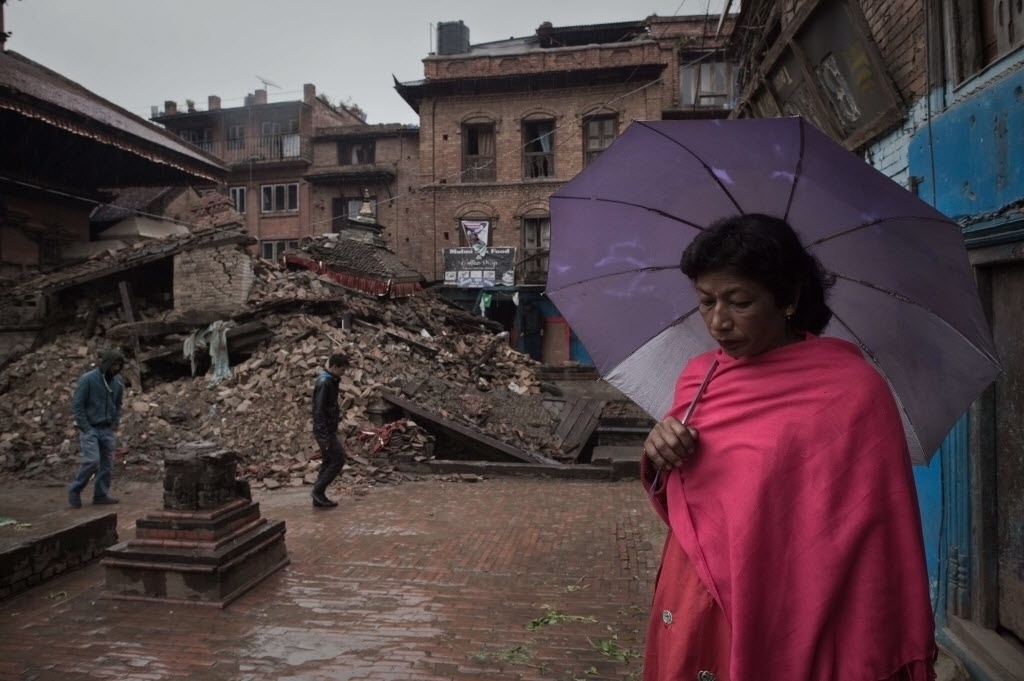
The seasonal monsoon brings heavy daily rains, as well as the threat of floods or landslides. Last year, torrential monsoon rains in Nepal caused multiple landslides and flooding; a particularly fatal landslide demolished an entire village east of Kathmandu, killing 156 people. Landslides may cause further fatalities, destroy makeshift shelters, and wipe out roads. Efforts by relief teams to reach remote regions may be hampered by rains that make it difficult for helicopters to fly and by landslides that bury roads in rubble.
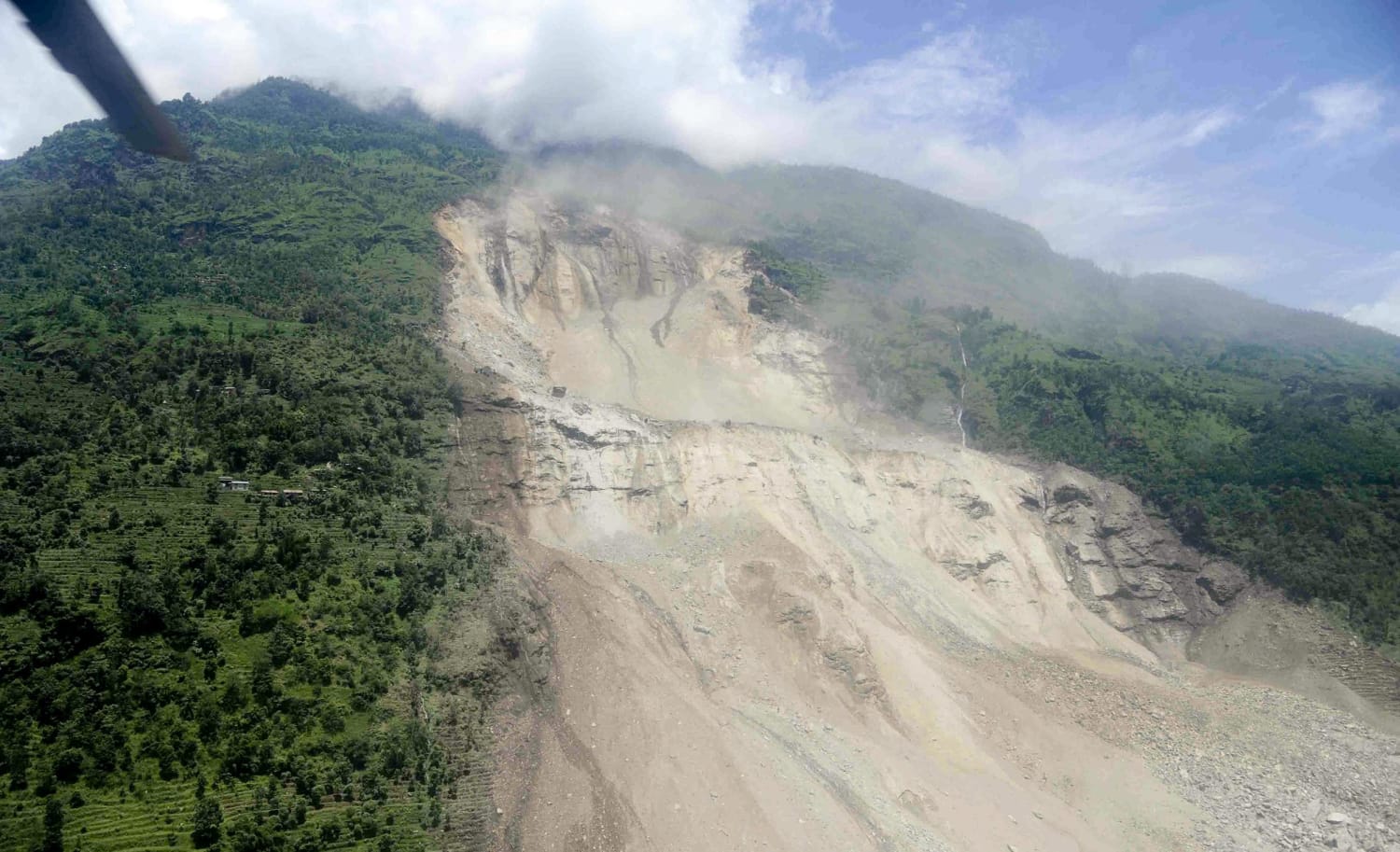
Rownak Khan, the UNICEF deputy representative in Nepal, has stated that the forthcoming monsoon season is a concern, as deadly disease outbreaks could be triggered by the wet and muddy conditions. “Hospitals are overflowing, water is scarce, bodies are still buried under the rubble and people are still sleeping in the open. This is a perfect breeding ground for diseases,” said Khan. Another UNICEF spokesperson, Chris Tidey, warned that the prevalence of diarrheal diseases, respiratory illnesses, measles and cholera will soar during the monsoon season if people are living in the open during heavy rains. Thirteen UK humanitarian organizations that are involved in relief efforts in the country cautioned that the hundreds of thousands living outdoors will be vulnerable to the coming monsoon. Many are currently living in the open, camping outdoors or in makeshift shelters, because 130,000 homes have been flattened by the quake.

As medical expert Dr. Nikhil Joshi forewarns, “We often look at things in terms of death toll from a disaster. But that really only tells a fraction of the story.” Humanitarian relief to Nepal will be an ongoing trial, especially given the logistical difficulties of providing appropriate goods and services in a mountainous region that will soon be subject to the hydrological extremes of the monsoon season. People who are considering donating to the relief efforts might consider the particular efforts that have been recommended by the Yale Himalaya Initiative.
